QUT PUN632: Leadership, Respect, and Healthcare Outcomes
VerifiedAdded on 2022/09/17
|11
|3133
|13
Essay
AI Summary
This essay delves into the critical role of respect within healthcare leadership, examining its multifaceted impact on organizational performance. It begins by defining respect in the context of healthcare and explores why it's considered essential in leadership literature, including the specific traits and behaviors leaders must exhibit. The essay also identifies contextual factors influencing healthcare leadership, such as the unique dynamics of healthcare teams and patient interactions. It analyzes the relationship between organizational culture, respect for people, and overall performance, drawing on leadership theories and the healthcare environment. The paper emphasizes the importance of a leader's vision, empathy, and optimism in fostering a culture of respect. It also discusses the company's role in cultivating a culture of respect in healthcare and the impact of leadership on the overall performance of a healthcare institution.
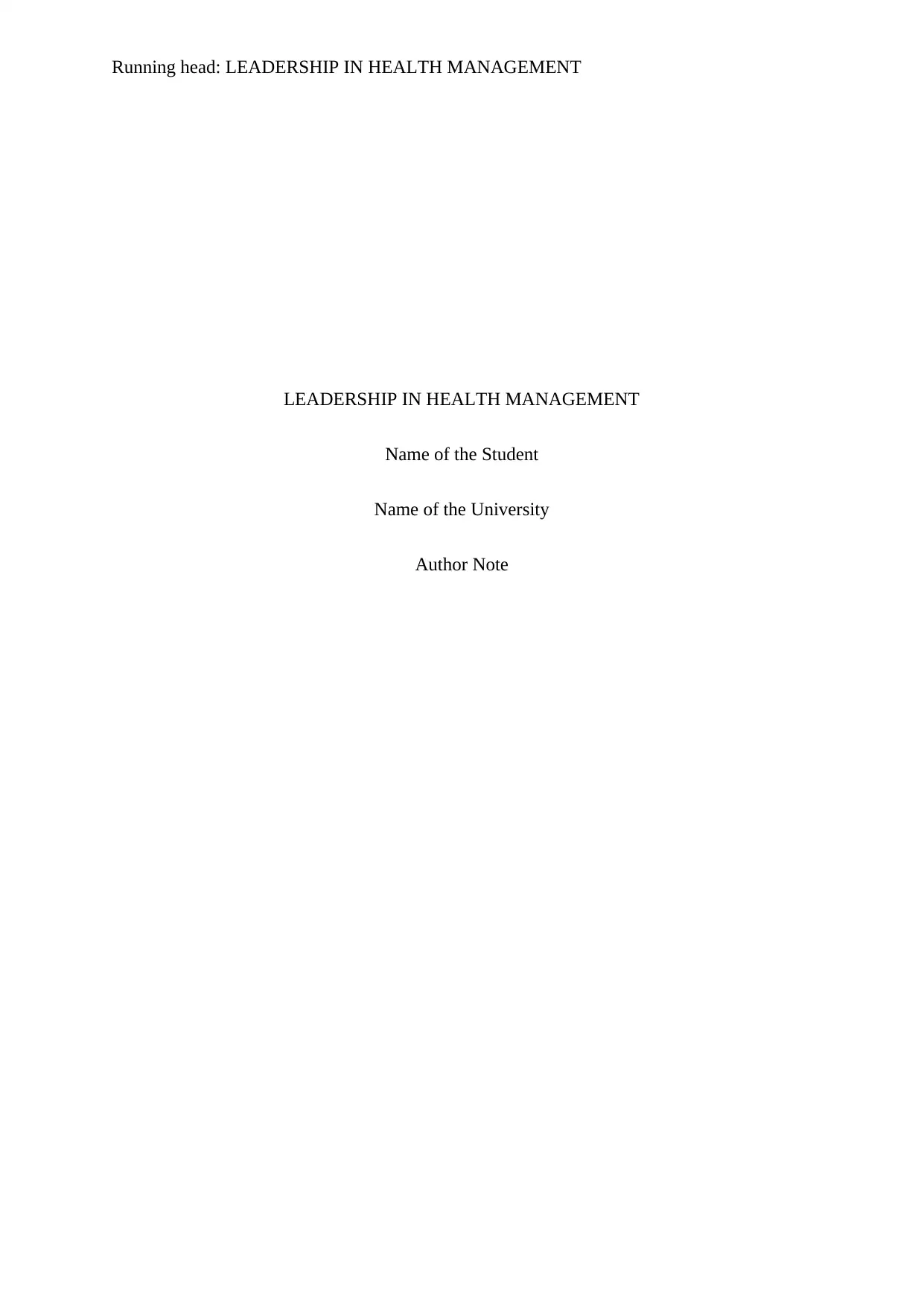
Running head: LEADERSHIP IN HEALTH MANAGEMENT
LEADERSHIP IN HEALTH MANAGEMENT
Name of the Student
Name of the University
Author Note
LEADERSHIP IN HEALTH MANAGEMENT
Name of the Student
Name of the University
Author Note
Paraphrase This Document
Need a fresh take? Get an instant paraphrase of this document with our AI Paraphraser
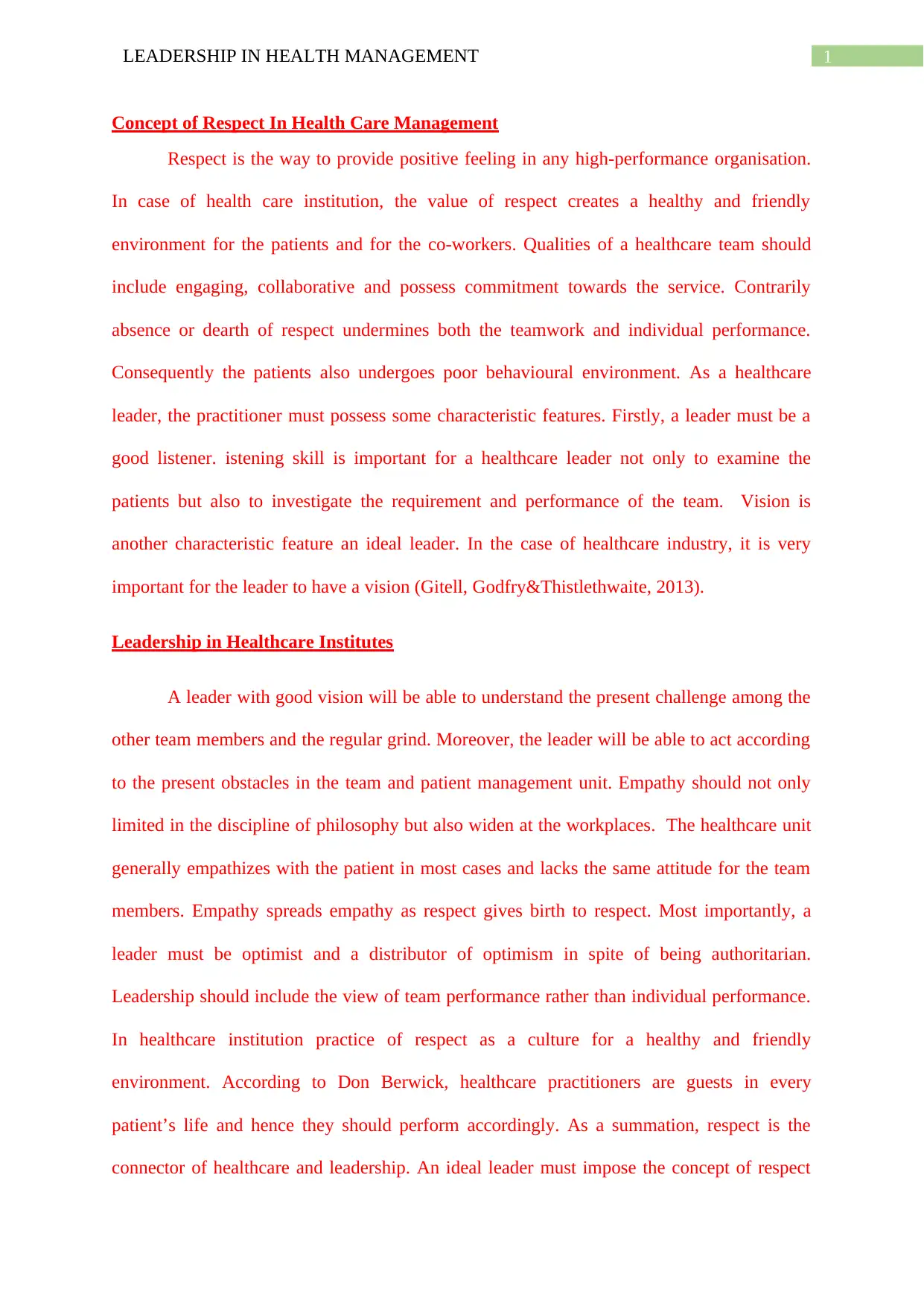
1LEADERSHIP IN HEALTH MANAGEMENT
Concept of Respect In Health Care Management
Respect is the way to provide positive feeling in any high-performance organisation.
In case of health care institution, the value of respect creates a healthy and friendly
environment for the patients and for the co-workers. Qualities of a healthcare team should
include engaging, collaborative and possess commitment towards the service. Contrarily
absence or dearth of respect undermines both the teamwork and individual performance.
Consequently the patients also undergoes poor behavioural environment. As a healthcare
leader, the practitioner must possess some characteristic features. Firstly, a leader must be a
good listener. istening skill is important for a healthcare leader not only to examine the
patients but also to investigate the requirement and performance of the team. Vision is
another characteristic feature an ideal leader. In the case of healthcare industry, it is very
important for the leader to have a vision (Gitell, Godfry&Thistlethwaite, 2013).
Leadership in Healthcare Institutes
A leader with good vision will be able to understand the present challenge among the
other team members and the regular grind. Moreover, the leader will be able to act according
to the present obstacles in the team and patient management unit. Empathy should not only
limited in the discipline of philosophy but also widen at the workplaces. The healthcare unit
generally empathizes with the patient in most cases and lacks the same attitude for the team
members. Empathy spreads empathy as respect gives birth to respect. Most importantly, a
leader must be optimist and a distributor of optimism in spite of being authoritarian.
Leadership should include the view of team performance rather than individual performance.
In healthcare institution practice of respect as a culture for a healthy and friendly
environment. According to Don Berwick, healthcare practitioners are guests in every
patient’s life and hence they should perform accordingly. As a summation, respect is the
connector of healthcare and leadership. An ideal leader must impose the concept of respect
Concept of Respect In Health Care Management
Respect is the way to provide positive feeling in any high-performance organisation.
In case of health care institution, the value of respect creates a healthy and friendly
environment for the patients and for the co-workers. Qualities of a healthcare team should
include engaging, collaborative and possess commitment towards the service. Contrarily
absence or dearth of respect undermines both the teamwork and individual performance.
Consequently the patients also undergoes poor behavioural environment. As a healthcare
leader, the practitioner must possess some characteristic features. Firstly, a leader must be a
good listener. istening skill is important for a healthcare leader not only to examine the
patients but also to investigate the requirement and performance of the team. Vision is
another characteristic feature an ideal leader. In the case of healthcare industry, it is very
important for the leader to have a vision (Gitell, Godfry&Thistlethwaite, 2013).
Leadership in Healthcare Institutes
A leader with good vision will be able to understand the present challenge among the
other team members and the regular grind. Moreover, the leader will be able to act according
to the present obstacles in the team and patient management unit. Empathy should not only
limited in the discipline of philosophy but also widen at the workplaces. The healthcare unit
generally empathizes with the patient in most cases and lacks the same attitude for the team
members. Empathy spreads empathy as respect gives birth to respect. Most importantly, a
leader must be optimist and a distributor of optimism in spite of being authoritarian.
Leadership should include the view of team performance rather than individual performance.
In healthcare institution practice of respect as a culture for a healthy and friendly
environment. According to Don Berwick, healthcare practitioners are guests in every
patient’s life and hence they should perform accordingly. As a summation, respect is the
connector of healthcare and leadership. An ideal leader must impose the concept of respect
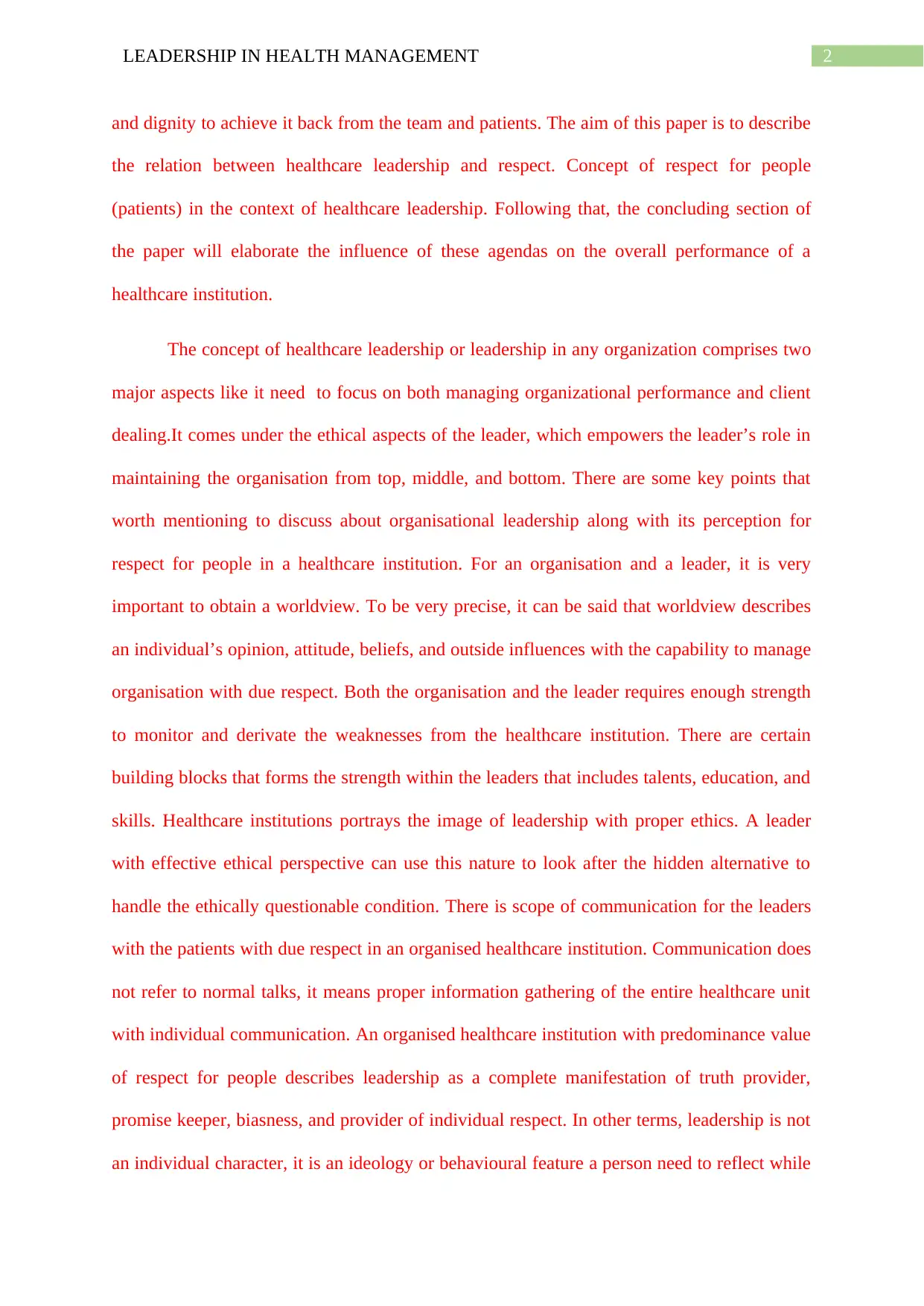
2LEADERSHIP IN HEALTH MANAGEMENT
and dignity to achieve it back from the team and patients. The aim of this paper is to describe
the relation between healthcare leadership and respect. Concept of respect for people
(patients) in the context of healthcare leadership. Following that, the concluding section of
the paper will elaborate the influence of these agendas on the overall performance of a
healthcare institution.
The concept of healthcare leadership or leadership in any organization comprises two
major aspects like it need to focus on both managing organizational performance and client
dealing.It comes under the ethical aspects of the leader, which empowers the leader’s role in
maintaining the organisation from top, middle, and bottom. There are some key points that
worth mentioning to discuss about organisational leadership along with its perception for
respect for people in a healthcare institution. For an organisation and a leader, it is very
important to obtain a worldview. To be very precise, it can be said that worldview describes
an individual’s opinion, attitude, beliefs, and outside influences with the capability to manage
organisation with due respect. Both the organisation and the leader requires enough strength
to monitor and derivate the weaknesses from the healthcare institution. There are certain
building blocks that forms the strength within the leaders that includes talents, education, and
skills. Healthcare institutions portrays the image of leadership with proper ethics. A leader
with effective ethical perspective can use this nature to look after the hidden alternative to
handle the ethically questionable condition. There is scope of communication for the leaders
with the patients with due respect in an organised healthcare institution. Communication does
not refer to normal talks, it means proper information gathering of the entire healthcare unit
with individual communication. An organised healthcare institution with predominance value
of respect for people describes leadership as a complete manifestation of truth provider,
promise keeper, biasness, and provider of individual respect. In other terms, leadership is not
an individual character, it is an ideology or behavioural feature a person need to reflect while
and dignity to achieve it back from the team and patients. The aim of this paper is to describe
the relation between healthcare leadership and respect. Concept of respect for people
(patients) in the context of healthcare leadership. Following that, the concluding section of
the paper will elaborate the influence of these agendas on the overall performance of a
healthcare institution.
The concept of healthcare leadership or leadership in any organization comprises two
major aspects like it need to focus on both managing organizational performance and client
dealing.It comes under the ethical aspects of the leader, which empowers the leader’s role in
maintaining the organisation from top, middle, and bottom. There are some key points that
worth mentioning to discuss about organisational leadership along with its perception for
respect for people in a healthcare institution. For an organisation and a leader, it is very
important to obtain a worldview. To be very precise, it can be said that worldview describes
an individual’s opinion, attitude, beliefs, and outside influences with the capability to manage
organisation with due respect. Both the organisation and the leader requires enough strength
to monitor and derivate the weaknesses from the healthcare institution. There are certain
building blocks that forms the strength within the leaders that includes talents, education, and
skills. Healthcare institutions portrays the image of leadership with proper ethics. A leader
with effective ethical perspective can use this nature to look after the hidden alternative to
handle the ethically questionable condition. There is scope of communication for the leaders
with the patients with due respect in an organised healthcare institution. Communication does
not refer to normal talks, it means proper information gathering of the entire healthcare unit
with individual communication. An organised healthcare institution with predominance value
of respect for people describes leadership as a complete manifestation of truth provider,
promise keeper, biasness, and provider of individual respect. In other terms, leadership is not
an individual character, it is an ideology or behavioural feature a person need to reflect while
⊘ This is a preview!⊘
Do you want full access?
Subscribe today to unlock all pages.

Trusted by 1+ million students worldwide
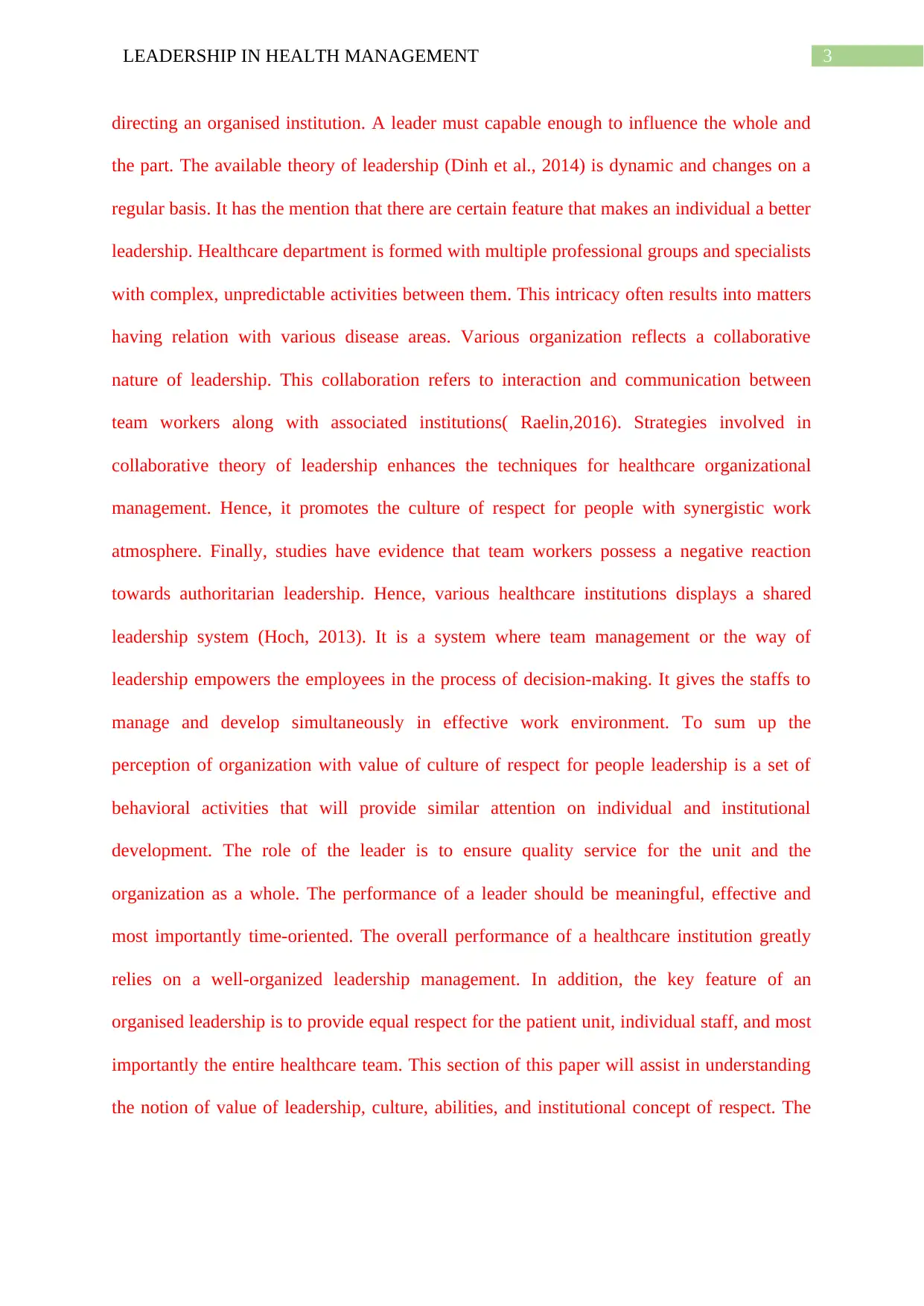
3LEADERSHIP IN HEALTH MANAGEMENT
directing an organised institution. A leader must capable enough to influence the whole and
the part. The available theory of leadership (Dinh et al., 2014) is dynamic and changes on a
regular basis. It has the mention that there are certain feature that makes an individual a better
leadership. Healthcare department is formed with multiple professional groups and specialists
with complex, unpredictable activities between them. This intricacy often results into matters
having relation with various disease areas. Various organization reflects a collaborative
nature of leadership. This collaboration refers to interaction and communication between
team workers along with associated institutions( Raelin,2016). Strategies involved in
collaborative theory of leadership enhances the techniques for healthcare organizational
management. Hence, it promotes the culture of respect for people with synergistic work
atmosphere. Finally, studies have evidence that team workers possess a negative reaction
towards authoritarian leadership. Hence, various healthcare institutions displays a shared
leadership system (Hoch, 2013). It is a system where team management or the way of
leadership empowers the employees in the process of decision-making. It gives the staffs to
manage and develop simultaneously in effective work environment. To sum up the
perception of organization with value of culture of respect for people leadership is a set of
behavioral activities that will provide similar attention on individual and institutional
development. The role of the leader is to ensure quality service for the unit and the
organization as a whole. The performance of a leader should be meaningful, effective and
most importantly time-oriented. The overall performance of a healthcare institution greatly
relies on a well-organized leadership management. In addition, the key feature of an
organised leadership is to provide equal respect for the patient unit, individual staff, and most
importantly the entire healthcare team. This section of this paper will assist in understanding
the notion of value of leadership, culture, abilities, and institutional concept of respect. The
directing an organised institution. A leader must capable enough to influence the whole and
the part. The available theory of leadership (Dinh et al., 2014) is dynamic and changes on a
regular basis. It has the mention that there are certain feature that makes an individual a better
leadership. Healthcare department is formed with multiple professional groups and specialists
with complex, unpredictable activities between them. This intricacy often results into matters
having relation with various disease areas. Various organization reflects a collaborative
nature of leadership. This collaboration refers to interaction and communication between
team workers along with associated institutions( Raelin,2016). Strategies involved in
collaborative theory of leadership enhances the techniques for healthcare organizational
management. Hence, it promotes the culture of respect for people with synergistic work
atmosphere. Finally, studies have evidence that team workers possess a negative reaction
towards authoritarian leadership. Hence, various healthcare institutions displays a shared
leadership system (Hoch, 2013). It is a system where team management or the way of
leadership empowers the employees in the process of decision-making. It gives the staffs to
manage and develop simultaneously in effective work environment. To sum up the
perception of organization with value of culture of respect for people leadership is a set of
behavioral activities that will provide similar attention on individual and institutional
development. The role of the leader is to ensure quality service for the unit and the
organization as a whole. The performance of a leader should be meaningful, effective and
most importantly time-oriented. The overall performance of a healthcare institution greatly
relies on a well-organized leadership management. In addition, the key feature of an
organised leadership is to provide equal respect for the patient unit, individual staff, and most
importantly the entire healthcare team. This section of this paper will assist in understanding
the notion of value of leadership, culture, abilities, and institutional concept of respect. The
Paraphrase This Document
Need a fresh take? Get an instant paraphrase of this document with our AI Paraphraser
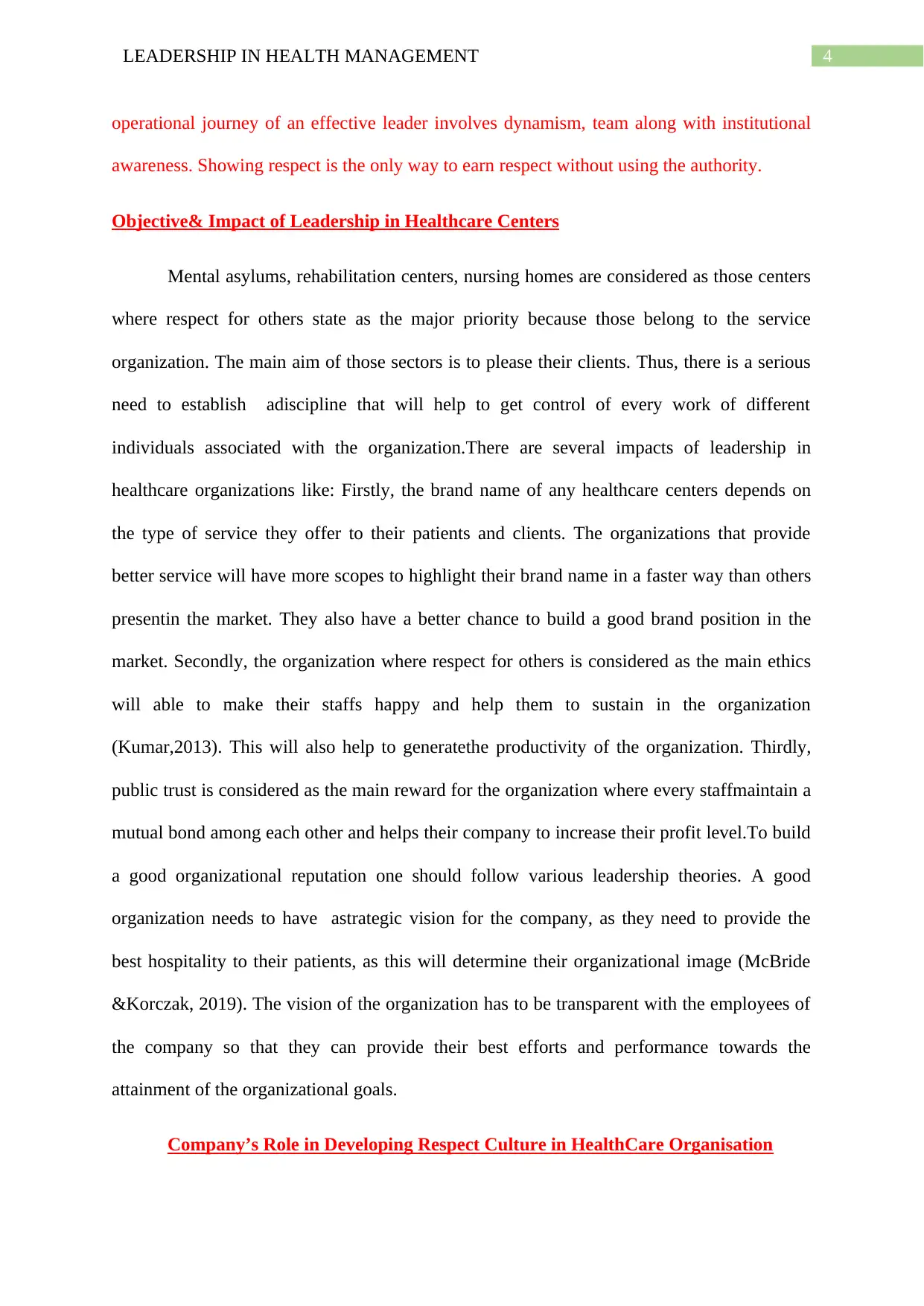
4LEADERSHIP IN HEALTH MANAGEMENT
operational journey of an effective leader involves dynamism, team along with institutional
awareness. Showing respect is the only way to earn respect without using the authority.
Objective& Impact of Leadership in Healthcare Centers
Mental asylums, rehabilitation centers, nursing homes are considered as those centers
where respect for others state as the major priority because those belong to the service
organization. The main aim of those sectors is to please their clients. Thus, there is a serious
need to establish adiscipline that will help to get control of every work of different
individuals associated with the organization.There are several impacts of leadership in
healthcare organizations like: Firstly, the brand name of any healthcare centers depends on
the type of service they offer to their patients and clients. The organizations that provide
better service will have more scopes to highlight their brand name in a faster way than others
presentin the market. They also have a better chance to build a good brand position in the
market. Secondly, the organization where respect for others is considered as the main ethics
will able to make their staffs happy and help them to sustain in the organization
(Kumar,2013). This will also help to generatethe productivity of the organization. Thirdly,
public trust is considered as the main reward for the organization where every staffmaintain a
mutual bond among each other and helps their company to increase their profit level.To build
a good organizational reputation one should follow various leadership theories. A good
organization needs to have astrategic vision for the company, as they need to provide the
best hospitality to their patients, as this will determine their organizational image (McBride
&Korczak, 2019). The vision of the organization has to be transparent with the employees of
the company so that they can provide their best efforts and performance towards the
attainment of the organizational goals.
Company’s Role in Developing Respect Culture in HealthCare Organisation
operational journey of an effective leader involves dynamism, team along with institutional
awareness. Showing respect is the only way to earn respect without using the authority.
Objective& Impact of Leadership in Healthcare Centers
Mental asylums, rehabilitation centers, nursing homes are considered as those centers
where respect for others state as the major priority because those belong to the service
organization. The main aim of those sectors is to please their clients. Thus, there is a serious
need to establish adiscipline that will help to get control of every work of different
individuals associated with the organization.There are several impacts of leadership in
healthcare organizations like: Firstly, the brand name of any healthcare centers depends on
the type of service they offer to their patients and clients. The organizations that provide
better service will have more scopes to highlight their brand name in a faster way than others
presentin the market. They also have a better chance to build a good brand position in the
market. Secondly, the organization where respect for others is considered as the main ethics
will able to make their staffs happy and help them to sustain in the organization
(Kumar,2013). This will also help to generatethe productivity of the organization. Thirdly,
public trust is considered as the main reward for the organization where every staffmaintain a
mutual bond among each other and helps their company to increase their profit level.To build
a good organizational reputation one should follow various leadership theories. A good
organization needs to have astrategic vision for the company, as they need to provide the
best hospitality to their patients, as this will determine their organizational image (McBride
&Korczak, 2019). The vision of the organization has to be transparent with the employees of
the company so that they can provide their best efforts and performance towards the
attainment of the organizational goals.
Company’s Role in Developing Respect Culture in HealthCare Organisation
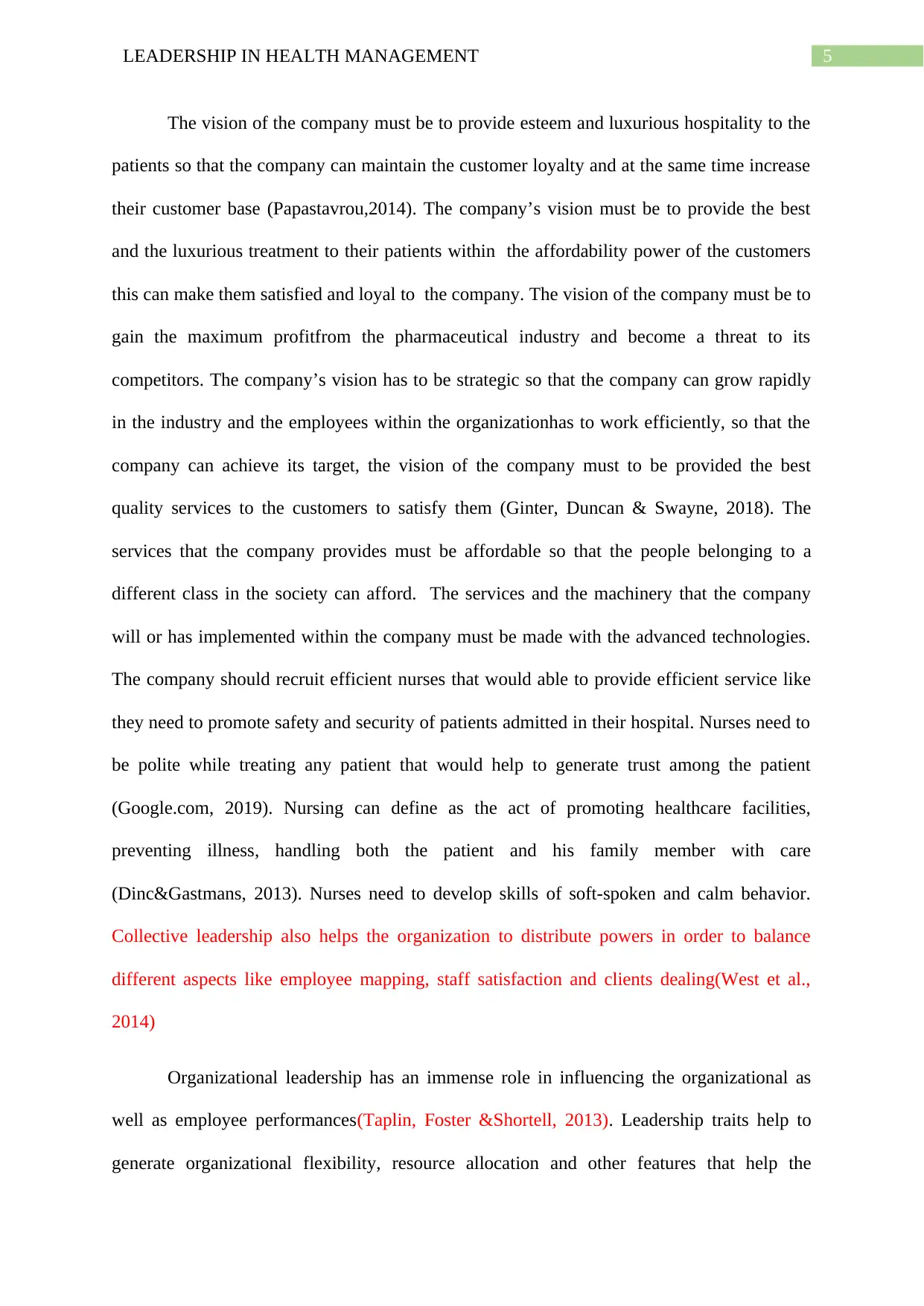
5LEADERSHIP IN HEALTH MANAGEMENT
The vision of the company must be to provide esteem and luxurious hospitality to the
patients so that the company can maintain the customer loyalty and at the same time increase
their customer base (Papastavrou,2014). The company’s vision must be to provide the best
and the luxurious treatment to their patients within the affordability power of the customers
this can make them satisfied and loyal to the company. The vision of the company must be to
gain the maximum profitfrom the pharmaceutical industry and become a threat to its
competitors. The company’s vision has to be strategic so that the company can grow rapidly
in the industry and the employees within the organizationhas to work efficiently, so that the
company can achieve its target, the vision of the company must to be provided the best
quality services to the customers to satisfy them (Ginter, Duncan & Swayne, 2018). The
services that the company provides must be affordable so that the people belonging to a
different class in the society can afford. The services and the machinery that the company
will or has implemented within the company must be made with the advanced technologies.
The company should recruit efficient nurses that would able to provide efficient service like
they need to promote safety and security of patients admitted in their hospital. Nurses need to
be polite while treating any patient that would help to generate trust among the patient
(Google.com, 2019). Nursing can define as the act of promoting healthcare facilities,
preventing illness, handling both the patient and his family member with care
(Dinc&Gastmans, 2013). Nurses need to develop skills of soft-spoken and calm behavior.
Collective leadership also helps the organization to distribute powers in order to balance
different aspects like employee mapping, staff satisfaction and clients dealing(West et al.,
2014)
Organizational leadership has an immense role in influencing the organizational as
well as employee performances(Taplin, Foster &Shortell, 2013). Leadership traits help to
generate organizational flexibility, resource allocation and other features that help the
The vision of the company must be to provide esteem and luxurious hospitality to the
patients so that the company can maintain the customer loyalty and at the same time increase
their customer base (Papastavrou,2014). The company’s vision must be to provide the best
and the luxurious treatment to their patients within the affordability power of the customers
this can make them satisfied and loyal to the company. The vision of the company must be to
gain the maximum profitfrom the pharmaceutical industry and become a threat to its
competitors. The company’s vision has to be strategic so that the company can grow rapidly
in the industry and the employees within the organizationhas to work efficiently, so that the
company can achieve its target, the vision of the company must to be provided the best
quality services to the customers to satisfy them (Ginter, Duncan & Swayne, 2018). The
services that the company provides must be affordable so that the people belonging to a
different class in the society can afford. The services and the machinery that the company
will or has implemented within the company must be made with the advanced technologies.
The company should recruit efficient nurses that would able to provide efficient service like
they need to promote safety and security of patients admitted in their hospital. Nurses need to
be polite while treating any patient that would help to generate trust among the patient
(Google.com, 2019). Nursing can define as the act of promoting healthcare facilities,
preventing illness, handling both the patient and his family member with care
(Dinc&Gastmans, 2013). Nurses need to develop skills of soft-spoken and calm behavior.
Collective leadership also helps the organization to distribute powers in order to balance
different aspects like employee mapping, staff satisfaction and clients dealing(West et al.,
2014)
Organizational leadership has an immense role in influencing the organizational as
well as employee performances(Taplin, Foster &Shortell, 2013). Leadership traits help to
generate organizational flexibility, resource allocation and other features that help the
⊘ This is a preview!⊘
Do you want full access?
Subscribe today to unlock all pages.

Trusted by 1+ million students worldwide
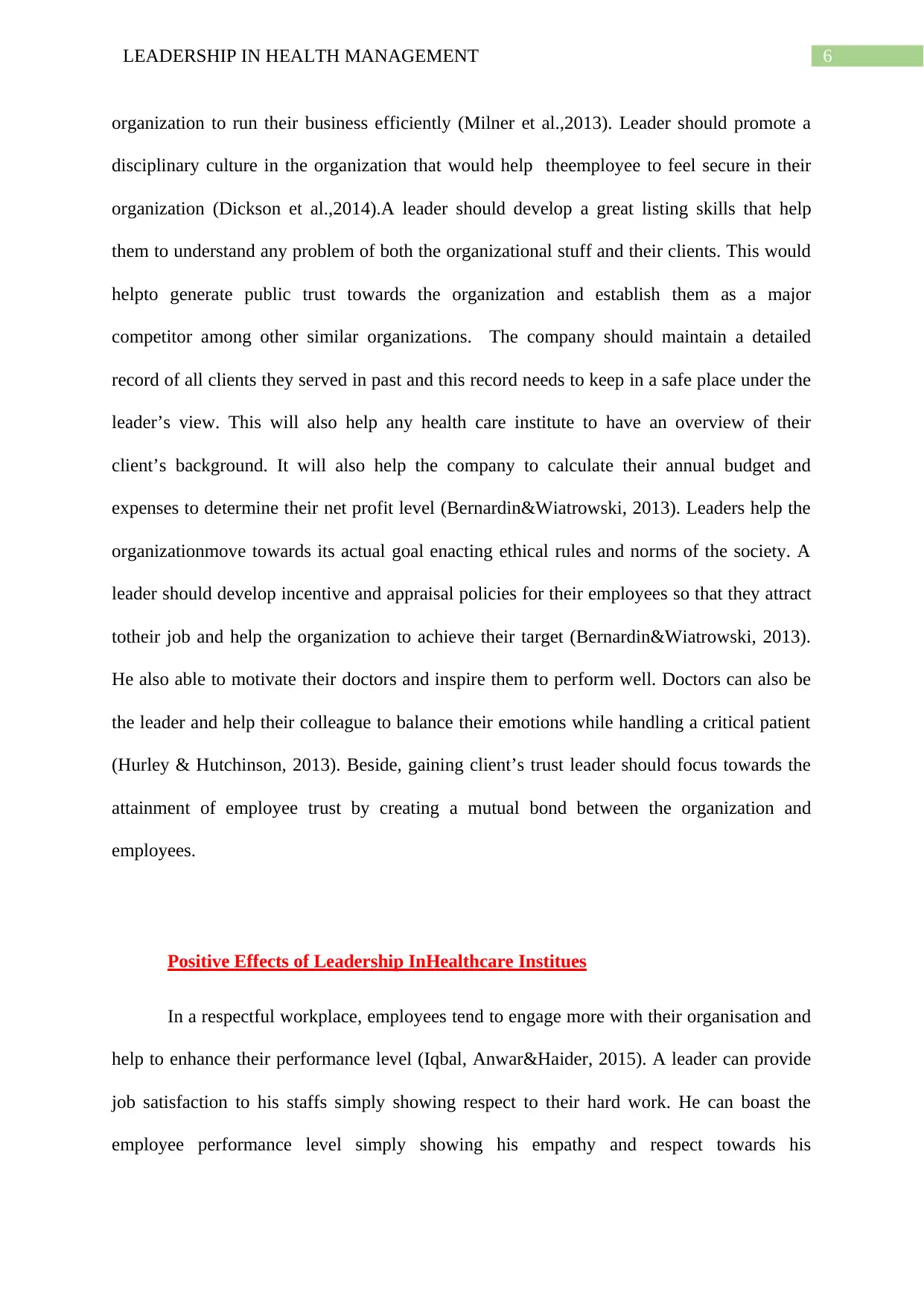
6LEADERSHIP IN HEALTH MANAGEMENT
organization to run their business efficiently (Milner et al.,2013). Leader should promote a
disciplinary culture in the organization that would help theemployee to feel secure in their
organization (Dickson et al.,2014).A leader should develop a great listing skills that help
them to understand any problem of both the organizational stuff and their clients. This would
helpto generate public trust towards the organization and establish them as a major
competitor among other similar organizations. The company should maintain a detailed
record of all clients they served in past and this record needs to keep in a safe place under the
leader’s view. This will also help any health care institute to have an overview of their
client’s background. It will also help the company to calculate their annual budget and
expenses to determine their net profit level (Bernardin&Wiatrowski, 2013). Leaders help the
organizationmove towards its actual goal enacting ethical rules and norms of the society. A
leader should develop incentive and appraisal policies for their employees so that they attract
totheir job and help the organization to achieve their target (Bernardin&Wiatrowski, 2013).
He also able to motivate their doctors and inspire them to perform well. Doctors can also be
the leader and help their colleague to balance their emotions while handling a critical patient
(Hurley & Hutchinson, 2013). Beside, gaining client’s trust leader should focus towards the
attainment of employee trust by creating a mutual bond between the organization and
employees.
Positive Effects of Leadership InHealthcare Institues
In a respectful workplace, employees tend to engage more with their organisation and
help to enhance their performance level (Iqbal, Anwar&Haider, 2015). A leader can provide
job satisfaction to his staffs simply showing respect to their hard work. He can boast the
employee performance level simply showing his empathy and respect towards his
organization to run their business efficiently (Milner et al.,2013). Leader should promote a
disciplinary culture in the organization that would help theemployee to feel secure in their
organization (Dickson et al.,2014).A leader should develop a great listing skills that help
them to understand any problem of both the organizational stuff and their clients. This would
helpto generate public trust towards the organization and establish them as a major
competitor among other similar organizations. The company should maintain a detailed
record of all clients they served in past and this record needs to keep in a safe place under the
leader’s view. This will also help any health care institute to have an overview of their
client’s background. It will also help the company to calculate their annual budget and
expenses to determine their net profit level (Bernardin&Wiatrowski, 2013). Leaders help the
organizationmove towards its actual goal enacting ethical rules and norms of the society. A
leader should develop incentive and appraisal policies for their employees so that they attract
totheir job and help the organization to achieve their target (Bernardin&Wiatrowski, 2013).
He also able to motivate their doctors and inspire them to perform well. Doctors can also be
the leader and help their colleague to balance their emotions while handling a critical patient
(Hurley & Hutchinson, 2013). Beside, gaining client’s trust leader should focus towards the
attainment of employee trust by creating a mutual bond between the organization and
employees.
Positive Effects of Leadership InHealthcare Institues
In a respectful workplace, employees tend to engage more with their organisation and
help to enhance their performance level (Iqbal, Anwar&Haider, 2015). A leader can provide
job satisfaction to his staffs simply showing respect to their hard work. He can boast the
employee performance level simply showing his empathy and respect towards his
Paraphrase This Document
Need a fresh take? Get an instant paraphrase of this document with our AI Paraphraser
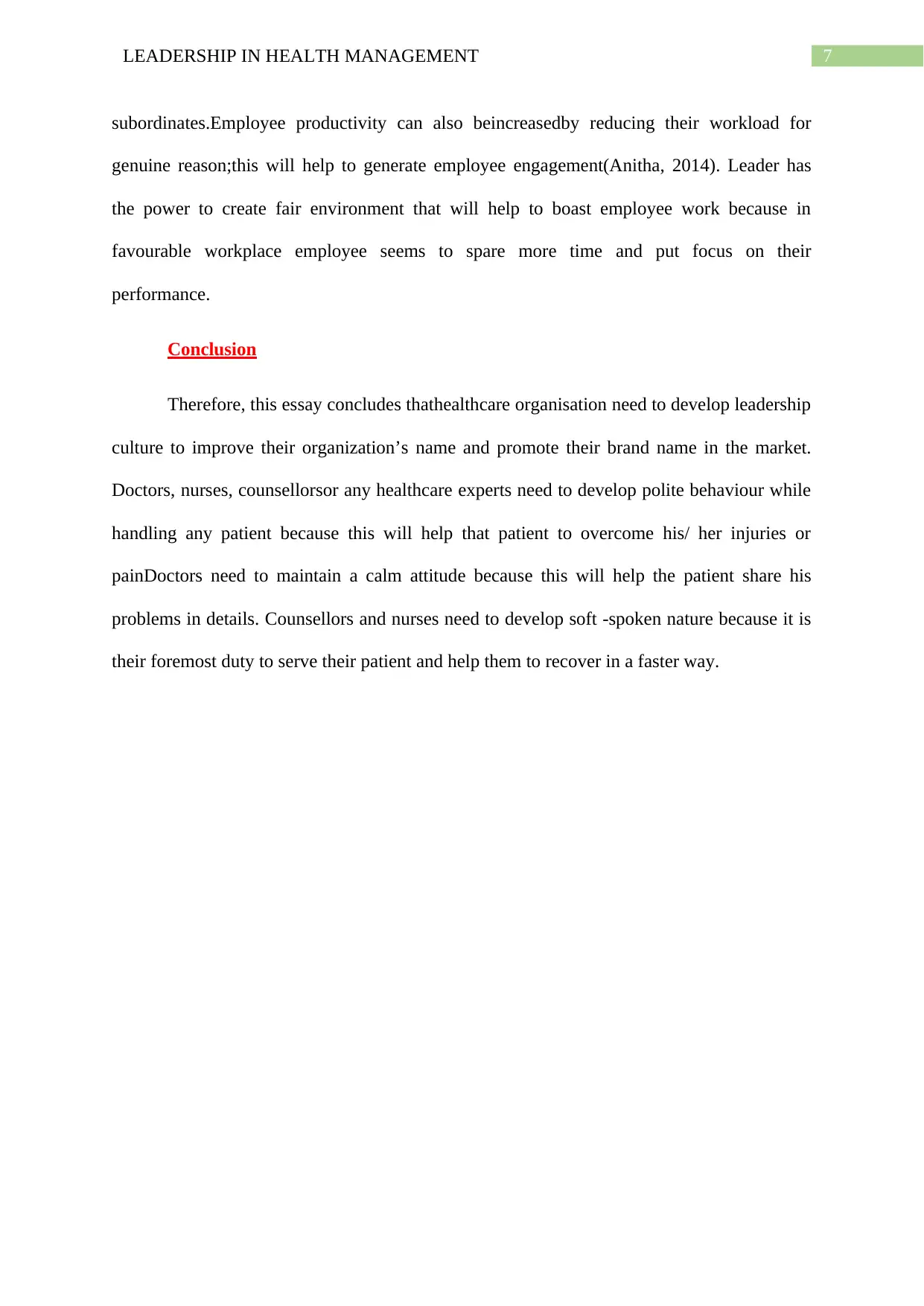
7LEADERSHIP IN HEALTH MANAGEMENT
subordinates.Employee productivity can also beincreasedby reducing their workload for
genuine reason;this will help to generate employee engagement(Anitha, 2014). Leader has
the power to create fair environment that will help to boast employee work because in
favourable workplace employee seems to spare more time and put focus on their
performance.
Conclusion
Therefore, this essay concludes thathealthcare organisation need to develop leadership
culture to improve their organization’s name and promote their brand name in the market.
Doctors, nurses, counsellorsor any healthcare experts need to develop polite behaviour while
handling any patient because this will help that patient to overcome his/ her injuries or
painDoctors need to maintain a calm attitude because this will help the patient share his
problems in details. Counsellors and nurses need to develop soft -spoken nature because it is
their foremost duty to serve their patient and help them to recover in a faster way.
subordinates.Employee productivity can also beincreasedby reducing their workload for
genuine reason;this will help to generate employee engagement(Anitha, 2014). Leader has
the power to create fair environment that will help to boast employee work because in
favourable workplace employee seems to spare more time and put focus on their
performance.
Conclusion
Therefore, this essay concludes thathealthcare organisation need to develop leadership
culture to improve their organization’s name and promote their brand name in the market.
Doctors, nurses, counsellorsor any healthcare experts need to develop polite behaviour while
handling any patient because this will help that patient to overcome his/ her injuries or
painDoctors need to maintain a calm attitude because this will help the patient share his
problems in details. Counsellors and nurses need to develop soft -spoken nature because it is
their foremost duty to serve their patient and help them to recover in a faster way.

8LEADERSHIP IN HEALTH MANAGEMENT
Reference
Bernardin, H. J., &Wiatrowski, M. (2013). Performance appraisal. Psychology and
Policing, 257.
Dickson, G., Owen, K., Sebastian, A., Fulop, L., Dadich, A., Fitzgerald, A., ...& Smyth, A.
(2014). Health LEADS Australia and implications for medical leadership. Leadership
in Health Services.
Dinç, L., &Gastmans, C. (2013). Trust in nurse–patient relationships: A literature
review. Nursing ethics, 20(5), 501-516.
Dinh, J. E., Lord, R. G., Gardner, W. L., Meuser, J. D., Liden, R. C., & Hu, J. (2014).
Leadership theory and research in the new millennium: Current theoretical
trends and changing perspectives. The Leadership Quarterly, 25(1), 36-62.
Ginter, P. M., Duncan, W. J., & Swayne, L. E. (2018). The strategic management of health
care organizations. John Wiley & Sons.
Gittell, J. H., Godfrey, M., &Thistlethwaite, J. (2013). Interprofessional collaborative
practice and relational coordination: improving healthcare through
relationships.
Gopee, N., & Galloway, J. (2017). Leadership and management in healthcare. Sage.
Hoch, J. E. (2013). Shared leadership and innovation: The role of vertical leadership
and employee integrity. Journal of Business and Psychology, 28(2), 159-174.
Hurley, J., & Hutchinson, M. (2013). Setting a course: A critical review of the literature on
nurse leadership in Australia. Contemporary nurse, 43(2), 178-182.
Reference
Bernardin, H. J., &Wiatrowski, M. (2013). Performance appraisal. Psychology and
Policing, 257.
Dickson, G., Owen, K., Sebastian, A., Fulop, L., Dadich, A., Fitzgerald, A., ...& Smyth, A.
(2014). Health LEADS Australia and implications for medical leadership. Leadership
in Health Services.
Dinç, L., &Gastmans, C. (2013). Trust in nurse–patient relationships: A literature
review. Nursing ethics, 20(5), 501-516.
Dinh, J. E., Lord, R. G., Gardner, W. L., Meuser, J. D., Liden, R. C., & Hu, J. (2014).
Leadership theory and research in the new millennium: Current theoretical
trends and changing perspectives. The Leadership Quarterly, 25(1), 36-62.
Ginter, P. M., Duncan, W. J., & Swayne, L. E. (2018). The strategic management of health
care organizations. John Wiley & Sons.
Gittell, J. H., Godfrey, M., &Thistlethwaite, J. (2013). Interprofessional collaborative
practice and relational coordination: improving healthcare through
relationships.
Gopee, N., & Galloway, J. (2017). Leadership and management in healthcare. Sage.
Hoch, J. E. (2013). Shared leadership and innovation: The role of vertical leadership
and employee integrity. Journal of Business and Psychology, 28(2), 159-174.
Hurley, J., & Hutchinson, M. (2013). Setting a course: A critical review of the literature on
nurse leadership in Australia. Contemporary nurse, 43(2), 178-182.
⊘ This is a preview!⊘
Do you want full access?
Subscribe today to unlock all pages.

Trusted by 1+ million students worldwide
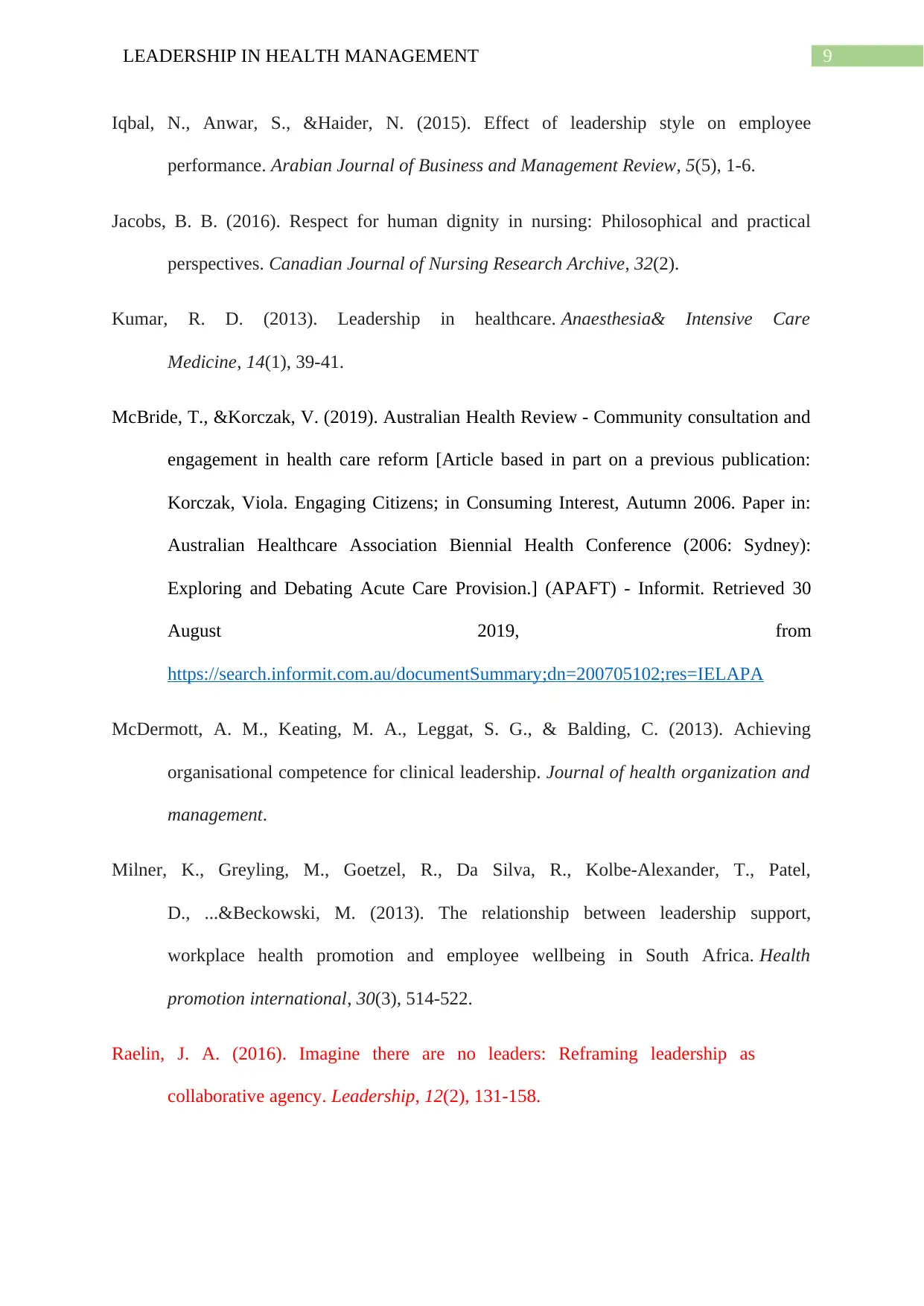
9LEADERSHIP IN HEALTH MANAGEMENT
Iqbal, N., Anwar, S., &Haider, N. (2015). Effect of leadership style on employee
performance. Arabian Journal of Business and Management Review, 5(5), 1-6.
Jacobs, B. B. (2016). Respect for human dignity in nursing: Philosophical and practical
perspectives. Canadian Journal of Nursing Research Archive, 32(2).
Kumar, R. D. (2013). Leadership in healthcare. Anaesthesia& Intensive Care
Medicine, 14(1), 39-41.
McBride, T., &Korczak, V. (2019). Australian Health Review - Community consultation and
engagement in health care reform [Article based in part on a previous publication:
Korczak, Viola. Engaging Citizens; in Consuming Interest, Autumn 2006. Paper in:
Australian Healthcare Association Biennial Health Conference (2006: Sydney):
Exploring and Debating Acute Care Provision.] (APAFT) - Informit. Retrieved 30
August 2019, from
https://search.informit.com.au/documentSummary;dn=200705102;res=IELAPA
McDermott, A. M., Keating, M. A., Leggat, S. G., & Balding, C. (2013). Achieving
organisational competence for clinical leadership. Journal of health organization and
management.
Milner, K., Greyling, M., Goetzel, R., Da Silva, R., Kolbe-Alexander, T., Patel,
D., ...&Beckowski, M. (2013). The relationship between leadership support,
workplace health promotion and employee wellbeing in South Africa. Health
promotion international, 30(3), 514-522.
Raelin, J. A. (2016). Imagine there are no leaders: Reframing leadership as
collaborative agency. Leadership, 12(2), 131-158.
Iqbal, N., Anwar, S., &Haider, N. (2015). Effect of leadership style on employee
performance. Arabian Journal of Business and Management Review, 5(5), 1-6.
Jacobs, B. B. (2016). Respect for human dignity in nursing: Philosophical and practical
perspectives. Canadian Journal of Nursing Research Archive, 32(2).
Kumar, R. D. (2013). Leadership in healthcare. Anaesthesia& Intensive Care
Medicine, 14(1), 39-41.
McBride, T., &Korczak, V. (2019). Australian Health Review - Community consultation and
engagement in health care reform [Article based in part on a previous publication:
Korczak, Viola. Engaging Citizens; in Consuming Interest, Autumn 2006. Paper in:
Australian Healthcare Association Biennial Health Conference (2006: Sydney):
Exploring and Debating Acute Care Provision.] (APAFT) - Informit. Retrieved 30
August 2019, from
https://search.informit.com.au/documentSummary;dn=200705102;res=IELAPA
McDermott, A. M., Keating, M. A., Leggat, S. G., & Balding, C. (2013). Achieving
organisational competence for clinical leadership. Journal of health organization and
management.
Milner, K., Greyling, M., Goetzel, R., Da Silva, R., Kolbe-Alexander, T., Patel,
D., ...&Beckowski, M. (2013). The relationship between leadership support,
workplace health promotion and employee wellbeing in South Africa. Health
promotion international, 30(3), 514-522.
Raelin, J. A. (2016). Imagine there are no leaders: Reframing leadership as
collaborative agency. Leadership, 12(2), 131-158.
Paraphrase This Document
Need a fresh take? Get an instant paraphrase of this document with our AI Paraphraser
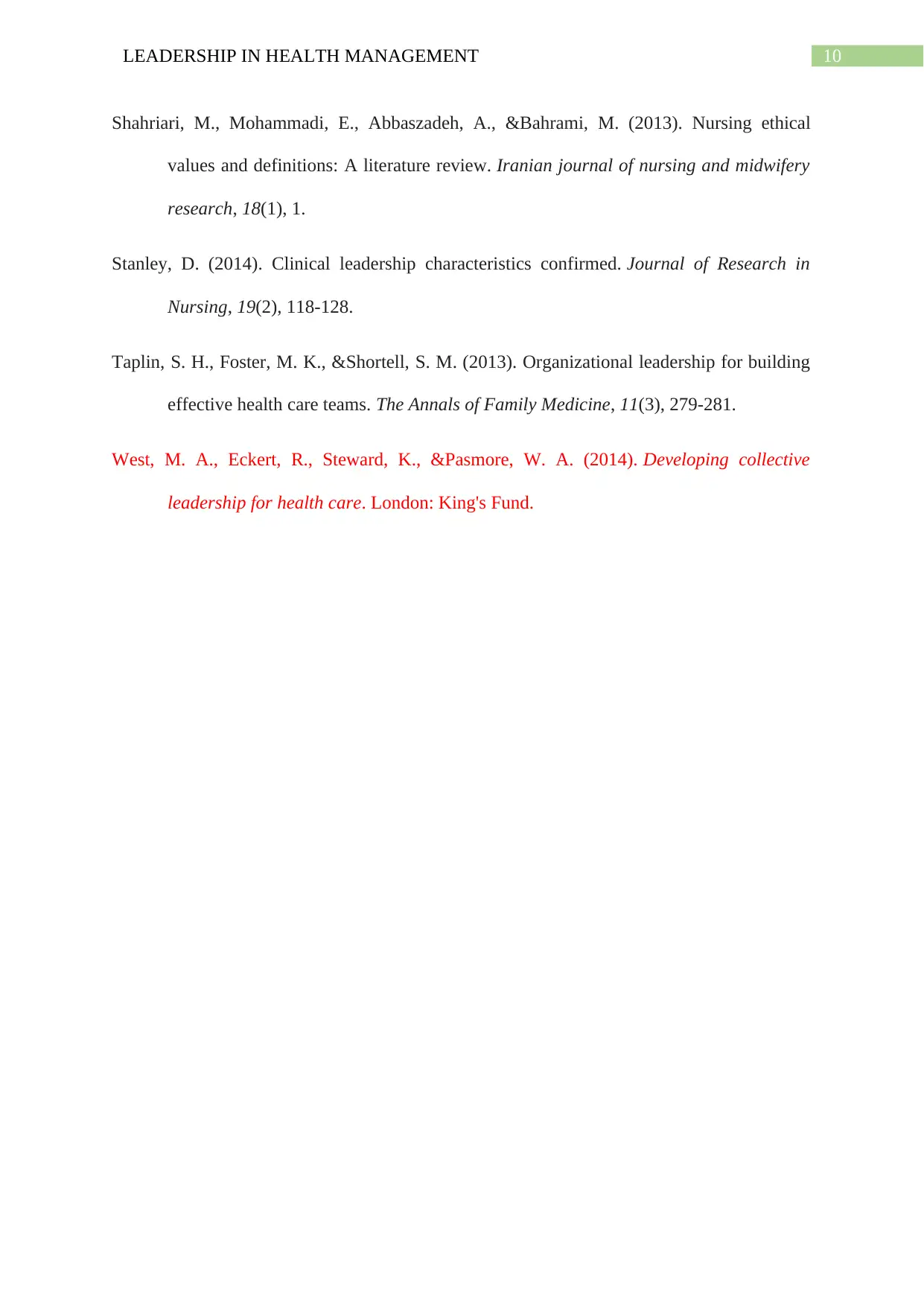
10LEADERSHIP IN HEALTH MANAGEMENT
Shahriari, M., Mohammadi, E., Abbaszadeh, A., &Bahrami, M. (2013). Nursing ethical
values and definitions: A literature review. Iranian journal of nursing and midwifery
research, 18(1), 1.
Stanley, D. (2014). Clinical leadership characteristics confirmed. Journal of Research in
Nursing, 19(2), 118-128.
Taplin, S. H., Foster, M. K., &Shortell, S. M. (2013). Organizational leadership for building
effective health care teams. The Annals of Family Medicine, 11(3), 279-281.
West, M. A., Eckert, R., Steward, K., &Pasmore, W. A. (2014). Developing collective
leadership for health care. London: King's Fund.
Shahriari, M., Mohammadi, E., Abbaszadeh, A., &Bahrami, M. (2013). Nursing ethical
values and definitions: A literature review. Iranian journal of nursing and midwifery
research, 18(1), 1.
Stanley, D. (2014). Clinical leadership characteristics confirmed. Journal of Research in
Nursing, 19(2), 118-128.
Taplin, S. H., Foster, M. K., &Shortell, S. M. (2013). Organizational leadership for building
effective health care teams. The Annals of Family Medicine, 11(3), 279-281.
West, M. A., Eckert, R., Steward, K., &Pasmore, W. A. (2014). Developing collective
leadership for health care. London: King's Fund.
1 out of 11
Related Documents
Your All-in-One AI-Powered Toolkit for Academic Success.
+13062052269
info@desklib.com
Available 24*7 on WhatsApp / Email
![[object Object]](/_next/static/media/star-bottom.7253800d.svg)
Unlock your academic potential
Copyright © 2020–2025 A2Z Services. All Rights Reserved. Developed and managed by ZUCOL.





